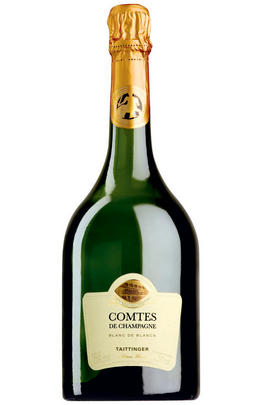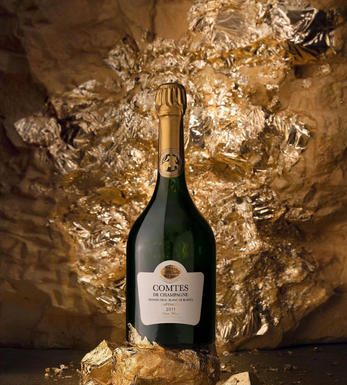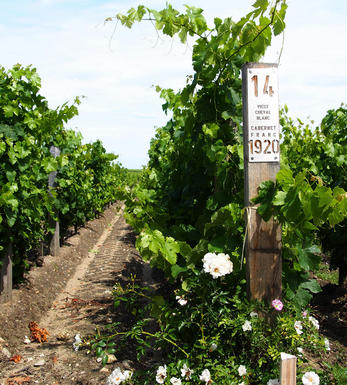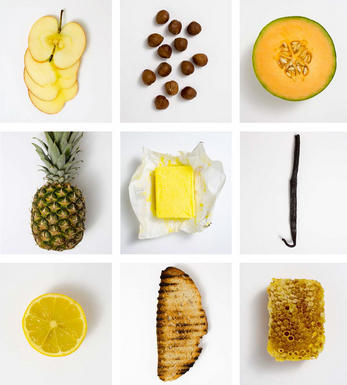
2011 Champagne Taittinger, Comtes de Champagne, Blanc de Blancs, Brut

Critics reviews
9 years on the lees, disgorged April 2021, 9 g/l dosage.
An insider Champagne, the Comtes de Champagne from Taittinger 2011 is at a great moment to begin drinking. A Blanc de Blancs made entirely from Chardonnay grapes sourced from entirely from Grand Cru vineyards in Avize, Chouilly, Cramant, Le Mesnil-sur-Oger and Oger, this is accomplished and moreish, with plenty of grip, green apple, quince and citrus fruit, with expertly-maintained kicks of citrus peel and apricot pit through the palate, deepening in complexity and exotic fruit expression in the glass.
Drink 2022 - 2038
Jane Anson, JaneAnson.com (June 2022)
From grand cru vineyards in Avize, Chouilly, Cramant, Le Mesnil-sur-Oger and Oger. Aged for nine years in Taittinger's particularly deep cellars. Dosage 9 g/l.
Quite a deep greenish primrose yellow. Meaty, substantial, quite savoury evolution on the nose. Bone-dry finish but no shortage of rather captivating fruit before then. Very appetising with good steady bead and no aggressive froth. A very successful Comtes with a deep undertow. This may have been a challenging vintage but the Taittinger team seem to have risen well to the challenges.
Drink 2021 - 2029
Jancis Robinson MW, JancisRobinson.com (November 2021)
After the tightly coiled, hyper-concentrated 2008, Taittinger's 2011 Brut Blanc de Blancs Comtes de Champagne represents a more immediate, charming rendition of this cuvée. Bursting from the glass with aromas of orchard and stone fruit mingled with notions of pastry cream, blanched almonds and mandarin, it's medium to full-bodied, pillowy and fleshy, with a soft and enveloping profile, lively acids and a pretty pinpoint mousse. Readers might think of the 2011 as a somewhat less reductive and less intense stylistic sibling of the 2006, and as it takes on more toasty complexity with bottle age, it will make for immensely seductive drinking.
Drink 2021 - 2035
William Kelley, Wine Advocate (October 2021)
A firm, fresh Comtes with a tight and composed palate. It’s full-bodied with a racy mid-palate. Long and persistent. Very structured with phenolics and acidity. Minerally. Floral, too. Refreshing and energetic.
Drink or hold
James Suckling, JamesSuckling.com (May 2021)
Dosage: 9g/L. Disgorged: April 2021.
100% Chardonnay sourced from five grand cru villages: Avize, Chouilly, Cramant, Mesnil-sur-Oger and Oger. Superb bouquet revealing scents of mirabelle plums, orchard fruits, brioche, pastry, and liquorice, complicated by classy autolytic notes. On the palate, this remarkable 2011 has a tauter and more fine-boned texture than usual, which is enhanced by bubbles of striking finesse and delicacy. This is indeed a very refined, chamber-music-like Comtes de Champagne that ends ethereally with airy harmonics and chalky notes infused with candied lemon.
Drink 2021 - 2040
Yohan Castaing, Decanter.com (September 2021)
The 2011 Champagne Blanc de Blancs Comte de Champagne is from all the Côte de Blancs Grand Crus except for Oiry. With a kiss of toasted brioche, caramel apple, and a hint of saline, this wine gets more savoury as it opens, although it has a bit of greenness. The palate is full, with a fine mousse and a dusty feel of chalk, as well as fresh and pithy citrus. It has a reasonably long finish, although perhaps not up to par for the tête de cuvée. It is drinking well now but is likely best for relatively early drinking.
Drink 2022 - 2033
Audrey Frick, JebDunnuck.com (November 2022)
About this WINE

Champagne Taittinger
Taittinger is one of the few family-owned independent Champagne houses in Reims. It produces a very classy Non-Vintage blend and complex Vintage Champagnes as well.
Its top Champagne is Comtes De Champagne - first produced in 1952, it is made from 100% Chardonnay grapes from 6 Grand Cru sites in the Côte de Blancs. This is finely aromatic, rich, creamy Blanc de Blancs at its best, though patience is required as the wine should not be approached for at least ten years.

Blanc de Blancs
In Champagne, the term Blanc de Blancs designates Champagnes made only from Chardonnay grapes. The vineyards located between Cramant and Mesnil-sur-Oger in Cote de Blancs yield the best examples of the style.
A classic Blanc de Blancs is restrained and elegant when young, yet with ageing it develops a mouth-coating brioche richness that overlays an intense expression of fruitiness. Blanc de Blancs are endowed with longer ageing potential than a typical Blanc de Noirs.
Recommended Producers: Salon, Billecart Salmon, Jacques Selosse, Dom Ruinart, Krug, Le Mesnil Grand Cru, Guy Larmandier

Chardonnay
Chardonnay is often seen as the king of white wine grapes and one of the most widely planted in the world It is suited to a wide variety of soils, though it excels in soils with a high limestone content as found in Champagne, Chablis, and the Côte D`Or.
Burgundy is Chardonnay's spiritual home and the best White Burgundies are dry, rich, honeyed wines with marvellous poise, elegance and balance. They are unquestionably the finest dry white wines in the world. Chardonnay plays a crucial role in the Champagne blend, providing structure and finesse, and is the sole grape in Blanc de Blancs.
It is quantitatively important in California and Australia, is widely planted in Chile and South Africa, and is the second most widely planted grape in New Zealand. In warm climates Chardonnay has a tendency to develop very high sugar levels during the final stages of ripening and this can occur at the expense of acidity. Late picking is a common problem and can result in blowsy and flabby wines that lack structure and definition.
Recently in the New World, we have seen a move towards more elegant, better- balanced and less oak-driven Chardonnays, and this is to be welcomed.


Buying options
Add to wishlist
Description
The 2011 Taittinger Comtes de Champagne is superb with generous, bright aromas of lemon cream, stone fruits, baked pastry and almonds. The palate has a subtle verve: rich but not overbearing and its weight is carried with deftness and elegance. There is freshness here and a fine mousse brings a lively energy. Beautiful acidity and with extraordinary length, it finishes with a twist of salinity leaving you reaching for a second sip.
Drink 2022 - 2038
Larissa Buckley, Account Manager, Berry Bros. & Rudd
wine at a glance
Delivery and quality guarantee